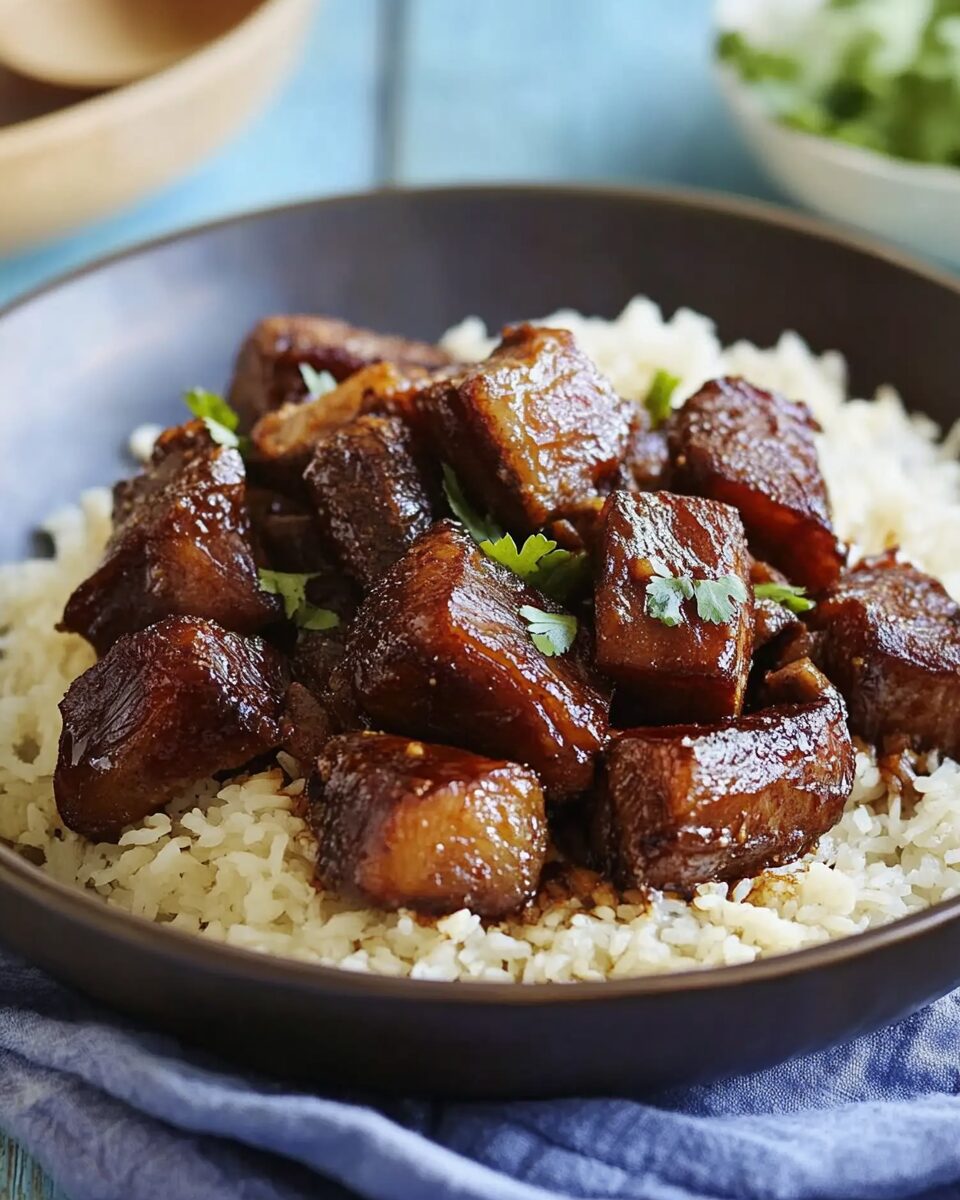Pork Belly Adobo is a dish that captures the heart of Filipino cuisine with its perfect balance of savory, tangy, and slightly sweet flavors. The pork belly becomes melt-in-your-mouth tender after slow simmering in a rich soy sauce, vinegar, and garlic broth, then finishes with a slight crisp for texture contrast.
This classic comfort food is ideal for family gatherings, cozy dinners, or when you simply crave something deeply satisfying. Serve it with plenty of fluffy white rice to soak up the luscious sauce. Once you taste it, Pork Belly Adobo will surely become a regular in your home-cooked favorites!
Full recipe:
Ingredients:
-
2 pounds pork belly, cut into 2-inch pieces
-
6 cloves garlic, smashed
-
3 bay leaves
-
1 teaspoon whole black peppercorns
-
1/2 cup soy sauce
-
1/2 cup cider vinegar
-
1/2 cup water
-
2 tablespoons brown sugar
-
2 tablespoons vegetable oil
-
Cooked white rice, for serving
Directions:
-
In a large bowl, combine the pork belly, garlic, bay leaves, peppercorns, soy sauce, vinegar, and water. Let marinate for at least 30 minutes or overnight for deeper flavor.
-
Transfer the pork belly and marinade into a Dutch oven or heavy pot. Add the brown sugar and bring to a simmer over medium-high heat.
-
Cover, reduce the heat to low, and cook for 1 hour, stirring occasionally, until the pork is very tender.
-
Remove the lid, increase the heat to medium, and cook until the sauce thickens and the pork browns slightly, about 10–15 minutes.
-
In a separate skillet, heat the vegetable oil over medium-high heat. Fry the pork pieces until crispy on the edges, about 3–5 minutes.
-
Serve hot over steamed white rice, spooning extra sauce on top.
Prep Time: 15 minutes | Cooking Time: 1 hour 30 minutes | Total Time: 1 hour 45 minutes
Kcal: 645 kcal | Servings: 6 servings
Historical and Cultural Significance
The origins of adobo date back to pre-colonial Philippines when indigenous people used vinegar and salt to preserve meat in the tropical climate. When Spanish colonizers arrived in the 16th century, they observed this cooking method and gave it the name “adobo,” which means “marinade” or “sauce” in Spanish. Over time, the technique evolved, incorporating soy sauce — a later influence from Chinese traders — and adapting into the rich, deeply flavored dish known today.
In the Philippines, adobo isn’t just food; it’s a symbol of identity and national pride. Every household has its version of adobo, each slightly different depending on the family tradition, regional influences, or even just the cook’s mood that day. Pork belly adobo, with its rich fattiness, represents indulgence and comfort — a dish often reserved for special family gatherings, holidays, or when loved ones come home after a long time away.
Flavor Profile and What Makes It Special
Pork belly adobo’s flavor is a harmonious marriage of saltiness, acidity, sweetness, and umami. The soy sauce provides the deep, savory backbone; vinegar adds a bright tanginess that cuts through the richness of the pork; garlic and bay leaves infuse aromatic warmth; and a hint of brown sugar balances everything with a subtle sweetness.
The star ingredient — pork belly — contributes immensely to the dish’s magic. Pork belly is a fatty, flavorful cut that, when cooked slowly, transforms into tender, juicy bites with crispy edges if finished off by pan-frying or broiling. The fat renders into the sauce, giving it a velvety texture and an indulgent mouthfeel that makes the dish so satisfying.
What sets pork belly adobo apart from other braised dishes is how it walks the line between sharp vinegar notes and the lushness of slow-cooked meat. The contrast of crispy and tender textures, along with the complexity of flavors, keeps every bite interesting and memorable.
Common Variations of Pork Belly Adobo
While the basic formula of pork belly adobo is straightforward, there are countless regional and personal variations:
-
Adobo sa Gata: Some versions add coconut milk (gata) towards the end of cooking, giving the sauce a creamy richness that pairs beautifully with the pork’s fattiness.
-
Spicy Adobo: Adding whole chilies or a dash of chili flakes transforms the dish into a fiery version for spice lovers.
-
Dry Adobo: Some cooks simmer the dish until the sauce almost evaporates, creating a “dry” adobo where the pork belly is coated in an intensely flavorful glaze.
-
Adobong Puti: In some areas, adobo is made without soy sauce, resulting in a lighter, vinegar-forward version known as “white adobo.”
These variations reflect the dish’s adaptability — a key reason why adobo has remained beloved for generations.
Serving Suggestions
Pork belly adobo is traditionally served with steamed white rice, and for good reason. The rice acts as the perfect neutral base to soak up the deeply flavored sauce and balance the richness of the pork. In Filipino households, it’s common to see big bowls of adobo placed at the center of the table, surrounded by smaller side dishes such as sautéed vegetables (like kangkong, or water spinach), fresh tomato salads, or pickled papaya (atchara) to add brightness and crunch.
For a modern twist, some enjoy pork belly adobo with garlic fried rice and a sunny-side-up egg, turning it into a luxurious breakfast or brunch option.
Leftover pork belly adobo is also highly coveted. In fact, many aficionados argue that adobo tastes even better the next day, once the flavors have had time to deepen and meld together in the refrigerator.
Tips for Making the Best Pork Belly Adobo
-
Choose the Right Cut: Opt for a pork belly slab with a good balance of meat and fat for the best texture and flavor.
-
Marinate for Depth: Allow the pork to marinate for at least 30 minutes, but overnight is ideal for maximum flavor absorption.
-
Control the Vinegar: Do not stir the dish during the initial vinegar simmer; this helps mellow out the acidity without making the dish overly sour.
-
Balance the Flavors: Adjust soy sauce, vinegar, and sugar to your taste. Some like their adobo more vinegary, while others prefer it a bit sweeter.
-
Finish Strong: Frying the pork after braising creates those coveted crispy edges, adding another layer of flavor and texture.
Health and Nutritional Information
Pork belly adobo is undeniably indulgent due to the high fat content of the pork belly. However, it also offers a good source of protein and essential minerals like iron and zinc.
For those looking for a lighter version, it’s possible to substitute some or all of the pork belly with leaner cuts such as pork shoulder, chicken thighs, or even tofu for a plant-based twist. Reducing the amount of added sugar and using low-sodium soy sauce are other easy adjustments for a healthier take on the classic.
Despite its richness, pork belly adobo can be part of a balanced diet when enjoyed in moderation and paired with nutrient-dense sides like vegetables and whole grains.
Conclusion
Pork belly adobo is more than just a recipe; it’s a story of history, culture, and comfort passed down through generations. Its rich flavor, melt-in-your-mouth texture, and simple ingredients make it a dish that continues to captivate both Filipino families and food lovers around the world.
Whether you’re savoring it for the first time or revisiting a childhood favorite, pork belly adobo offers a timeless, heartwarming experience that’s as much about connection as it is about taste. Its versatility and depth of flavor guarantee that it will remain a beloved staple — not just in Filipino kitchens, but wherever good food is treasured.






